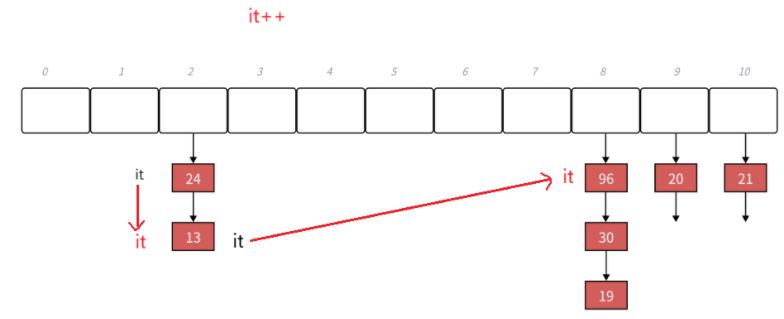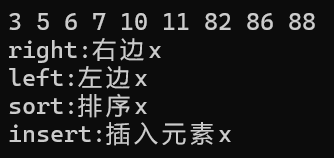【C++】22. 封装哈希表实现unordered_set和unordered_map
一、源码及框架分析
SGI-STL30版本源代码中没有unordered_map和unordered_set,SGI-STL30版本是C++11之前的STL版本,这两个容器是C++11之后才更新的。但是SGI-STL30实现了哈希表,容器的名字是hash_map和hash_set,他是作为⾮标准的容器出现的,⾮标准是指⾮C++标准规定必须实现的,源代码在hash_map/hash_set/stl_hash_map/stl_hash_set/stl_hashtable.h中。
hash_map和hash_set的实现结构框架核⼼部分截取出来如下:
//hash_set.h
#include <stl_hashtable.h>
#include <stl_hash_set.h>//hash_map.h
#include <stl_hashtable.h>
#include <stl_hash_map.h>//stl_hash_set.h
template <class Value>
struct __hashtable_node
{__hashtable_node* next;Value val;
}; template <class Value, class HashFcn = hash<Value>,class EqualKey = equal_to<Value>,class Alloc = alloc>class hash_set
{
private:typedef hashtable<Value, Value, HashFcn, identity<Value>,EqualKey, Alloc> ht;ht rep;
public:typedef typename ht::key_type key_type;typedef typename ht::value_type value_type;typedef typename ht::hasher hasher;typedef typename ht::key_equal key_equal;typedef typename ht::const_iterator iterator;typedef typename ht::const_iterator const_iterator;
};//stl_hash_map.h
template <class Key, class T, class HashFcn = hash<Key>,class EqualKey = equal_to<Key>,class Alloc = alloc>class hash_map
{
private:typedef hashtable<pair<const Key, T>, Key, HashFcn,select1st<pair<const Key, T> >, EqualKey, Alloc> ht;ht rep;public:typedef typename ht::key_type key_type;typedef T data_type;typedef T mapped_type;typedef typename ht::value_type value_type;typedef typename ht::hasher hasher;typedef typename ht::key_equal key_equal;typedef typename ht::iterator iterator;typedef typename ht::const_iterator const_iterator;
};// stl_hashtable.h
template <class Value, class Key, class HashFcn,class ExtractKey, class EqualKey,class Alloc>class hashtable {
public:typedef Key key_type;typedef Value value_type;typedef HashFcn hasher;typedef EqualKey key_equal;hasher hash_funct() const { return hash; }key_equal key_eq() const { return equals; }private:hasher hash;key_equal equals;ExtractKey get_key;typedef __hashtable_node<Value> node;vector<node*, Alloc> buckets;size_type num_elements;public:typedef __hashtable_iterator<Value, Key, HashFcn, ExtractKey, EqualKey,Alloc> iterator;pair<iterator, bool> insert_unique(const value_type& obj)const_iterator find(const key_type& key) const
};

- 通过画图分析可以看到,结构上hash_map和hash_set跟map和set的完全类似,复⽤同⼀个hashtable实现key和key/value结构,hash_set传给hash_table的是key,hash_map传给hash_table的是pair<constkey,value>。
二、模拟实现unordered_map和unordered_set
1、实现出复⽤哈希表的框架,并⽀持insert
-
参考源码框架,unordered_map和unordered_set复⽤之前我们实现的哈希表。
-
我们这⾥相⽐源码调整⼀下,key参数就⽤K,value参数就⽤V,哈希表中的数据类型,我们使⽤T。
-
其次跟map和set相⽐⽽⾔unordered_map和unordered_set的模拟实现类结构更复杂⼀点,但是⼤框架和思路是完全类似的。因为HashTable实现了泛型不知道T参数导致是K,还是pair<K,V>,那么insert内部进⾏插⼊时要⽤K对象转换成整形取模和K⽐较相等,因为pair的value不参与计算取模,且默认⽀持的是key和value⼀起⽐较相等,我们需要的任何时候只需要⽐较K对象,所以我们在unordered_map和unordered_set层分别实现⼀个MapKeyOfT和SetKeyOfT的仿函数传给HashTable的KeyOfT,然后HashTable中通过KeyOfT仿函数取出T类型对象中的K对象,再转换成整形取模和K⽐较相等,具体细节参考如下代码实现。
//UnorderedSet.h
namespace zsy
{template<class K, class Hash = HashFunc<K>>class unordered_set{struct SetKeyOfT{const K& operator()(const K& key){return key;}};public:bool insert(const K& key){return _ht.Insert(key);}private:hash_bucket::HashTable<K, K, SetKeyOfT, Hash> _ht;};
}//UnorderedMap.h
namespace zsy
{template<class K, class V, class Hash = HashFunc<K>>class unordered_map{struct MapKeyOfT{const K& operator()(const pair<K, V>& kv){return kv.first;}};public:bool insert(const pair<K, V>& kv){return _ht.Insert(kv);}private:hash_bucket::HashTable<K, pair<K, V>, MapKeyOfT, Hash> _ht;};
}// HashTable.h//仿函数: 转换为无符号整型
template<class K>
struct HashFunc
{size_t operator()(const K& key){return (size_t)key;}
};//特化: 将string类转换为无符号整型
template<>
struct HashFunc<string>
{size_t operator()(const string& s){//BKDR哈希算法size_t hash = 0;for (auto ch : s){hash += ch;hash *= 131;}return hash;}
};//素数表函数:用于哈希表初始化和扩容(取大于n的最小素数)
inline unsigned long _stl_next_prime(unsigned long n)
{static const int _stl_num_primes = 28;static const unsigned long _stl_prime_list[_stl_num_primes] = {53, 97, 193, 389, 769,1543, 3079, 6151, 12289, 24593,49157, 98317, 196613, 393241, 786433,1572869, 3145739, 6291469, 12582917, 25165843,50331653, 100663319, 201326611, 402653189, 805306457,1610612741, 3221225473, 4294967291};const unsigned long* first = _stl_prime_list;const unsigned long* last = _stl_prime_list + _stl_num_primes;const unsigned long* pos = lower_bound(first, last, n);//[first,second) >=nreturn pos == last ? *(last - 1) : *pos;
}namespace hash_bucket
{template<class T>struct HashNode{T _data;HashNode<T>* _next;HashNode(const T& data):_data(data), _next(nullptr){}};// 实现步骤: // 1、实现哈希表 // 2、封装unordered_map和unordered_set的框架 解决KeyOfT // 3、iterator // 4、const_iterator // 5、key不⽀持修改的问题 // 6、operator[] template<class K, class T, class KeyOfT, class Hash>class HashTable{typedef HashNode<T> Node;public:HashTable():_tables(_stl_next_prime(0), nullptr), _n(0){}HashTable(const HashTable& ht){_tables.resize(ht._tables.size(), nullptr);//初始化N个空节点_n = ht._n;//遍历源哈希表的每个桶,进行深拷贝for (size_t i = 0; i < ht._tables.size(); ++i){Node* cur = ht._tables[i];Node* newHead = nullptr;Node* tail = nullptr;//拷贝链表中的每个节点while (cur){Node* newnode = new Node(cur->_data); //深拷贝节点//尾插if (newHead == nullptr){newHead = newnode;tail = newnode;}else{tail->_next = newnode;tail = tail->_next;}cur = cur->_next;}_tables[i] = newHead;//将新链表头指针存入当前哈希表}}void Swap(HashTable& ht){_tables.swap(ht._tables);swap(_n, ht._n);}HashTable& operator=(HashTable ht){Swap(ht);return *this;}~HashTable(){//释放每个桶for (size_t i = 0; i < _tables.size(); ++i){Node* cur = _tables[i];while (cur){Node* next = cur->_next;delete cur;cur = next;}_tables[i] = nullptr;}}bool Insert(const T& data){//避免重复值插入 KeyOfT kot;Iterator it = Find(kot(data));if (it != End())return false;Hash hs;//负载因子=1时扩容if (_n == _tables.size()){vector<Node*> newTable(_stl_next_prime(_tables.size() + 1), nullptr);for (size_t i = 0; i < _tables.size(); ++i){Node* cur = _tables[i];while (cur){Node* next = cur->_next;//原数据头插到新表size_t hashi = hash(kot(cur->_data)) % newTable.size();cur->_next = newTable[hashi];newTable[hashi] = cur;cur = next;}_tables[i] = nullptr;//对应旧表清空}_tables.swap(newTable);}size_t hashi = hash(kot(data)) % _tables.size();//头插Node* newnode = new Node(data);newnode->_next = _tables[hashi];//新节点指向原链表头_tables[hashi] = newnode;//newnode成为新链表头++_n;return true;}private:vector<Node*> _tables;//指针数组size_t _n = 0;};
}
2、⽀持iterator的实现
iterator核⼼源代码
template <class Value, class Key, class HashFcn,class ExtractKey, class EqualKey, class Alloc>
struct __hashtable_iterator {typedef hashtable<Value, Key, HashFcn, ExtractKey, EqualKey, Alloc> hashtable;typedef __hashtable_iterator<Value, Key, HashFcn,ExtractKey, EqualKey, Alloc> iterator;typedef __hashtable_const_iterator<Value, Key, HashFcn,ExtractKey, EqualKey, Alloc> const_iterator;typedef __hashtable_node<Value> node;typedef forward_iterator_tag iterator_category;typedef Value value_type;node* cur;hashtable* ht;__hashtable_iterator(node* n, hashtable* tab) : cur(n), ht(tab) {}__hashtable_iterator() {}reference operator*() const { return cur->val; }
#ifndef __SGI_STL_NO_ARROW_OPERATORpointer operator->() const { return &(operator*()); }
#endif /* __SGI_STL_NO_ARROW_OPERATOR */iterator & operator++();iterator operator++(int);bool operator==(const iterator& it) const { return cur == it.cur; }bool operator!=(const iterator& it) const { return cur != it.cur; }
};template <class V, class K, class HF, class ExK, class EqK, class A>
__hashtable_iterator<V, K, HF, ExK, EqK, A>&
__hashtable_iterator<V, K, HF, ExK, EqK, A>::operator++()
{const node* old = cur;cur = cur->next;if (!cur) {size_type bucket = ht->bkt_num(old->val);while (!cur && ++bucket < ht->buckets.size())cur = ht->buckets[bucket];}return *this;
}iterator实现思路分析:
-
iterator实现的⼤框架跟list的iterator思路是⼀致的,⽤⼀个类型封装结点的指针,再通过重载运算符实现,迭代器像指针⼀样访问的⾏为,要注意的是哈希表的迭代器是单向迭代器。
-
这⾥的难点是operator++的实现。iterator中有⼀个指向结点的指针,如果当前桶下⾯还有结点,则结点的指针指向下⼀个结点即可。如果当前桶⾛完了,则需要想办法计算找到下⼀个桶。这⾥的难点反⽽是结构设计的问题,参考上⾯的源码,我们可以看到iterator中除了有结点的指针,还有哈希表对象的指针,这样当前桶⾛完了,要计算下⼀个桶就相对容易多了,⽤key值计算出当前桶位置,依次往后找下⼀个不为空的桶即可。

-
begin()返回第⼀个桶中第⼀个节点指针构造的迭代器,这⾥end()返回迭代器可以⽤空表⽰。
-
unordered_set的iterator也不⽀持修改,我们把unordered_set的第⼆个模板参数改成const K即可,
HashTable<K, const K, SetKeyOfT, Hash> _ht; -
unordered_map的iterator不⽀持修改key但是可以修改value,我们把unordered_map的第⼆个模板参数pair的第⼀个参数改成const K即可,
HashTable<K, pair<const K, V>, MapKeyOfT, Hash> _ht; -
⽀持完整的迭代器还有很多细节需要修改,具体参考下⾯代码。
//前置声明
template<class K, class T, class KeyOfT, class Hash>
class HashTable;template<class K, class T, class Ref, class Ptr, class KeyOfT, class Hash>
struct HTIterator
{typedef HashNode<T> Node;typedef HashTable<K, T, KeyOfT, Hash> HT;typedef HTIterator<K, T, Ref, Ptr, KeyOfT, Hash> Self;Node* _node;const HT* _ht;HTIterator(Node* node, const HT* ht):_node(node), _ht(ht){}Ref operator*(){return _node->_data;}Ptr operator->(){return &_node->_data;}bool operator==(const Self& s){return _node == s._node;}bool operator!=(const Self& s){return _node != s._node;}Self& operator++(){//当前桶还有数据,走下一个节点if (_node->_next){_node = _node->_next;}//当前桶走完了,找下一个不为空的桶else{KeyOfT kot;Hash hash;size_t hashi = hash(kot(_node->_data)) % _ht->_tables.size();++hashi;while (hashi < _ht->_tables.size()){_node = _ht->_tables[hashi];if (_node)break;else++hashi;}//走完所有桶,end()给的空_nodeif (hashi == _ht->_tables.size()){_node = nullptr;}}return *this;}
};template<class K, class T, class KeyOfT, class Hash>
class HashTable
{//友元声明 允许访问struct HTIteratortemplate<class K, class T, class Ref, class Ptr, class KeyOfT, class Hash>friend struct HTIterator;typedef HashNode<T> Node;
public:typedef HTIterator<K, T, T&, T*, KeyOfT, Hash> Iterator;typedef HTIterator<K, T, const T&, const T*, KeyOfT, Hash> ConstIterator;Iterator Begin(){//哈希表为空if (_n == 0)return End();//找第一个不为空的桶for (size_t i = 0; i < _tables.size(); ++i){Node* cur = _tables[i];if (cur){return Iterator(cur, this);}}//走完所有桶return End();}Iterator End(){return Iterator(nullptr, this);}ConstIterator Begin() const{if (_n == 0)return End();for (size_t i = 0; i < _tables.size(); ++i){Node* cur = _tables[i];if (cur){return ConstIterator(cur, this);}}return End();}ConstIterator End() const{return ConstIterator(nullptr, this);}
}
3、map⽀持[ ]
-
unordered_map要⽀持[]主要需要修改insert返回值⽀持,修改HashTable中的insert返回值为
pair<Iterator, bool> Insert(const T& data)。 -
有了insert⽀持[ ]实现就很简单了,具体参考下⾯代码实现。
//UnorderedMap.htemplate<class K, class V, class Hash = HashFunc<K>>V& operator[](const K& key)
{pair<iterator, bool> ret = insert({ key,V() });return ret.first->second;
}
4、封装实现的完整代码
1)HashTable.h
#pragma once#include<vector>//仿函数: 转换为无符号整型
template<class K>
struct HashFunc
{size_t operator()(const K& key){return (size_t)key;}
};//特化: 将string类转换为无符号整型
template<>
struct HashFunc<string>
{size_t operator()(const string& s){//BKDR哈希算法size_t hash = 0;for (auto ch : s){hash += ch;hash *= 131;}return hash;}
} ;//素数表函数:用于哈希表初始化和扩容(取大于n的最小素数)
inline unsigned long _stl_next_prime(unsigned long n)
{static const int _stl_num_primes = 28;static const unsigned long _stl_prime_list[_stl_num_primes] = {53, 97, 193, 389, 769,1543, 3079, 6151, 12289, 24593,49157, 98317, 196613, 393241, 786433,1572869, 3145739, 6291469, 12582917, 25165843,50331653, 100663319, 201326611, 402653189, 805306457,1610612741, 3221225473, 4294967291};const unsigned long* first = _stl_prime_list;const unsigned long* last = _stl_prime_list + _stl_num_primes;const unsigned long* pos = lower_bound(first, last, n);//[first,second) >=nreturn pos == last ? *(last - 1) : *pos;
}//哈希桶
namespace hash_bucket
{template<class T>struct HashNode{T _data;HashNode<T>* _next;HashNode(const T& data):_data(data),_next(nullptr){}};//前置声明template<class K, class T, class KeyOfT, class Hash>class HashTable;template<class K, class T, class Ref, class Ptr, class KeyOfT, class Hash>struct HTIterator{typedef HashNode<T> Node;typedef HashTable<K, T, KeyOfT, Hash> HT;typedef HTIterator<K, T, Ref, Ptr, KeyOfT, Hash> Self;Node* _node;const HT* _ht;HTIterator(Node* node, const HT* ht):_node(node), _ht(ht){}Ref operator*(){return _node->_data;}Ptr operator->(){return &_node->_data;}bool operator==(const Self& s){return _node == s._node;}bool operator!=(const Self& s){return _node != s._node;}Self& operator++(){//当前桶还有数据,走下一个节点if (_node->_next){_node = _node->_next;}//当前桶走完了,找下一个不为空的桶else{KeyOfT kot;Hash hash;size_t hashi = hash(kot(_node->_data)) % _ht->_tables.size();++hashi;while (hashi < _ht->_tables.size()){_node = _ht->_tables[hashi];if (_node)break;else++hashi;}//走完所有桶,end()给的空_nodeif (hashi == _ht->_tables.size()){_node = nullptr;}}return *this;}};template<class K, class T, class KeyOfT, class Hash>class HashTable{//友元声明 允许访问struct HTIteratortemplate<class K, class T, class Ref, class Ptr, class KeyOfT, class Hash>friend struct HTIterator;typedef HashNode<T> Node;public:typedef HTIterator<K, T, T&, T*, KeyOfT, Hash> Iterator;typedef HTIterator<K, T, const T&, const T*, KeyOfT, Hash> ConstIterator;Iterator Begin(){//哈希表为空if (_n == 0)return End();//找第一个不为空的桶for (size_t i = 0; i < _tables.size(); ++i){Node* cur = _tables[i];if (cur){return Iterator(cur, this);}}//走完所有桶return End();}Iterator End(){return Iterator(nullptr, this);}ConstIterator Begin() const{if (_n == 0)return End();for (size_t i = 0; i < _tables.size(); ++i){Node* cur = _tables[i];if (cur){return ConstIterator(cur, this);}}return End();}ConstIterator End() const{return ConstIterator(nullptr, this);}HashTable():_tables(_stl_next_prime(0), nullptr), _n(0){}HashTable(const HashTable& ht){_tables.resize(ht._tables.size(), nullptr);//初始化N个空节点_n = ht._n;//遍历源哈希表的每个桶,进行深拷贝for (size_t i = 0; i < ht._tables.size(); ++i){Node* cur = ht._tables[i];Node* newHead = nullptr;Node* tail = nullptr;//拷贝链表中的每个节点while (cur){Node* newnode = new Node(cur->_data); //深拷贝节点//尾插if (newHead == nullptr){newHead = newnode;tail = newnode;}else{tail->_next = newnode;tail = tail->_next;}cur = cur->_next;}_tables[i] = newHead;//将新链表头指针存入当前哈希表}}void Swap(HashTable& ht){_tables.swap(ht._tables);swap(_n, ht._n);}HashTable& operator=(HashTable ht){Swap(ht);return *this;}~HashTable(){//释放每个桶for (size_t i = 0; i < _tables.size(); ++i){Node* cur = _tables[i];while (cur){Node* next = cur->_next;delete cur;cur = next;}_tables[i] = nullptr;}}pair<Iterator,bool> Insert(const T& data){//避免重复值插入 KeyOfT kot;Iterator it = Find(kot(data));if (it != End())return { it,false };Hash hash;//负载因子=1时扩容if (_n == _tables.size()){vector<Node*> newTable(_stl_next_prime(_tables.size() + 1),nullptr);for (size_t i = 0; i < _tables.size(); ++i){Node* cur = _tables[i];while (cur){Node* next = cur->_next;//原数据头插到新表size_t hashi = hash(kot(cur->_data)) % newTable.size();cur->_next = newTable[hashi];newTable[hashi] = cur;cur = next;}_tables[i] = nullptr;//对应旧表清空}_tables.swap(newTable);}size_t hashi = hash(kot(data)) % _tables.size();//头插Node* newnode = new Node(data);newnode->_next = _tables[hashi];//新节点指向原链表头_tables[hashi] = newnode;//newnode成为新链表头++_n;return { Iterator(newnode,this),true };}Iterator Find(const K& key) {KeyOfT kot;Hash hash;size_t hashi = hash(key) % _tables.size();Node* cur = _tables[hashi];while (cur){if (kot(cur->_data) == key){return Iterator(cur, this);}cur = cur->_next;}return End();}bool Erase(const K& key){KeyOfT kot;Hash hash;size_t hashi = hash(key) % _tables.size();Node* prev = nullptr;Node* cur = _tables[hashi];while (cur){if (kot(cur->_data) == key){//头节点if (prev == nullptr){_tables[hashi] = cur->_next;}//中间节点else{prev->_next = cur->_next;}delete cur;--_n;return true;}else{prev = cur;cur = cur->_next;}}//节点不存在return false;}private:vector<Node*> _tables;//指针数组size_t _n = 0;};
}
2)UnorderedSet.h
#pragma once#include"HashTable.h"//UnorderedSet.h
namespace zsy
{template<class K, class Hash = HashFunc<K>>class unordered_set{struct SetKeyOfT{const K& operator()(const K& key){return key;}};public:typedef typename hash_bucket::HashTable<K, const K, SetKeyOfT, Hash>::Iterator iterator;typedef typename hash_bucket::HashTable<K, const K, SetKeyOfT, Hash>::ConstIterator const_iterator;iterator begin(){return _ht.Begin();}iterator end(){return _ht.End();}const_iterator begin() const{return _ht.Begin();}const_iterator end() const{return _ht.End();}pair<iterator, bool> insert(const K& key){return _ht.Insert(key);}iterator find(const K& key){return _ht.Find(key);}bool erase(const K& key){return _ht.Erase(key);}private:hash_bucket::HashTable<K, const K, SetKeyOfT, Hash> _ht;};
}
3)UnorderedMap.h
#pragma once#include"HashTable.h"//MyUnorderedMap.h
namespace zsy
{template<class K, class V, class Hash = HashFunc<K>>class unordered_map{struct MapKeyOfT{const K& operator()(const pair<K, V>& kv){return kv.first;}};public:typedef typename hash_bucket::HashTable<K, pair<const K, V>, MapKeyOfT, Hash>::Iterator iterator;typedef typename hash_bucket::HashTable<K, pair<const K, V>, MapKeyOfT, Hash>::ConstIterator const_iterator;iterator begin(){return _ht.Begin();}iterator end(){return _ht.End();}const_iterator begin() const{return _ht.Begin();}const_iterator end() const{return _ht.End();}V& operator[](const K& key){pair<iterator, bool> ret = insert({ key,V() });return ret.first->second;}pair<iterator, bool> insert(const pair<K, V>& kv){return _ht.Insert(kv);}iterator find(const K& key){return _ht.Find(key);}bool erase(const K& key){return _ht.Erase(key);}private:hash_bucket::HashTable<K, pair<const K, V>, MapKeyOfT, Hash> _ht;};
}
4)Test.cpp
接着对我们封装后的UnorderedSet和UnorderedMap进行测试:
#include<iostream>
using namespace std;#include"UnorderedMap.h"
#include"UnorderedSet.h"namespace zsy
{void test_unordered_set(){int a[] = { 3,11,86,7,88,82,10,5,6,7,6 };unordered_set<int> s;for (auto e : a){s.insert(e);}unordered_set<int>::iterator it = s.begin();while (it != s.end()){cout << *it << " ";++it;}cout << endl;}void test_unordered_map(){unordered_map<string, string> dict;dict.insert({ "left","左边" });dict.insert({ "right","右边" });dict.insert({ "insert","插入" });dict["sort"] = "排序";//[]实现插入dict["insert"] = "插入元素";//[]实现修改unordered_map<string, string>::iterator it = dict.begin();while (it != dict.end()){it->second += "x"; //it->first不允许修改,it->second允许修改cout << it->first << ":" << it->second << endl;++it;} }
}int main()
{zsy::test_unordered_set();zsy::test_unordered_map();return 0;
}
运行结果:

